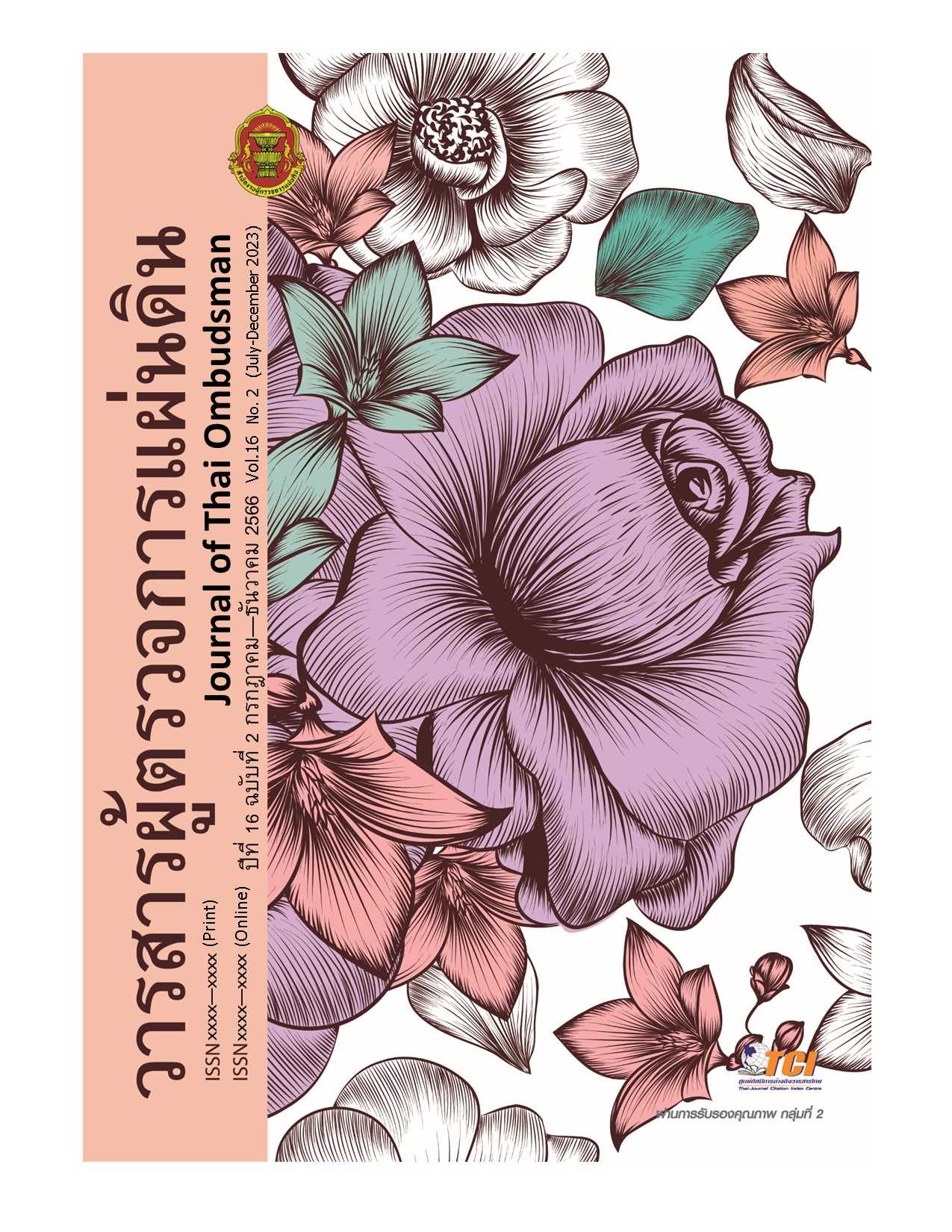Community Self-Governance: Case Studies of Community Forests in the Area of Kanchanaburi Province
Keywords:
Community Self-Governance, Ban Yang Thon Community Forest, , Ban Huai Saphan Samakkhi Community Forest, Kanchanaburi ProvinceAbstract
This study aimed to (1) analyze self-governance practices pertaining to community forests in Kanchanaburi Province, (2) study problems and obstacles encountered in self-governing pertaining to community forests in Kanchanaburi Province, and (3) offer guidelines for developing self-governance pertaining to community forests in Kanchanaburi Province.
This study utilized a qualitative research design. Data were collected from documents, and in-depth interviews with 31 informants, including (1) local operators in Yang Thon Village Community Forest, (2) local operators in Huai Saphan Samakkhi Village Community Forest, and (3) public officers. The data were analyzed by inductive analysis.
The data revealed the following findings. (1) Both community forests in Kanchanaburi Province demonstrated self-governance by adhering to multiple principles, including (a) community democracy, (b) flexible governance, (c) immediate response to work, (d) integration of activities across sectors, (e) shared accountability, and (f) primary utilization of existing community funds. (2) Major problems and obstacles encountered in self-governing pertaining to community forests in Kanchanaburi Province included insufficient budget allocation, limited availability of public personnel, and inadequate provision of materials and equipment required for community forest activities. (3) The guidelines for developing self-governance pertaining to community forests in Kanchanaburi Province emphasized the importance of public and private sector support in providing necessary resources for community forest operations, as it is crucial for maximizing the efficiency and effectiveness of community forest operations.
References
Amporn Tamronglak. (2010). kānbō̜rihān pokkhrō̜ng sāthārana : kānbō̜rihān rat kit nai satawat thī yīsipʻet. [Public Governance: Public Administration in the 21st Century]. Bangkok: Thammasat Printing House.
Berg, B.L. (2001). Qualitative Research Methods for the Social Sciences. (4thed.). Boston, MA: Allyn & Bacon.
čhaonāthī pāmai เจ้าหน้าที่ป่าไม้ (2023, March 31). Interview. Kanchanaburi Provincial Forest Center.
Citizens' Forest Network. (2022, October 5). kānčhatkān pāmai khō̜ng Thai. [Forest Management in Thailand]. Retrieved from https://thaicfnet.org/management/1/4
Community Forest Management Office. (2014). pā chumchon rūpbǣp kānphatthanā læ bō̜rihān čhatkān pā yāng yangyư̄n. [Community Forest, a Model for Sustainable Forest Development and Management]. Bangkok: Community Forest Management Office, Royal Forest Department.
Community Forest Management Office. (2022, October 20). pā chumchon tonbǣp withī khon withī pā čhangwat : Kānčhanaburī. [Model community forest, people's way of life, forest way, Province: Kanchanaburi]. Retrieved from https://
www.forest.go.th/ppd/network51/
Community Organizations Development Institute. (2011). chumchon čhatkān tonʻēng : khwāmmāi læ tūa chī wat. [Self-Governance Community: Definition and Indicators]. Journal of Community News, 130, 6-7.
Dale, E. (1968). Management: Theory and Practice. New York: McGraw-Hill.
Green Globe Institute. (2022, October 13). phon ngān rāngwan lūklōk sīkhīeo. [Green Globe Awards]. Retrieved from https://www.greenglobeinstitute.com/Frontend/Content.aspx?ContentID=85fec0c5-0120-4087-aa28-4452bf176af6
khana kammakān klum pā chum chon bā nayāng thōn khon thī nưng คณะกรรมการกลุ่มป่าชุมชนบ้านยางโทน คนที่ 1 (2023, April 11). Interview. Yang Thon Village Community Forest.
khana kammakān klum pā chum chon bā nayāng thōn khon thī sī, คณะกรรมการกลุ่มป่าชุมชนบ้านยางโทน คนที่ 4 (2023, April 11). Interview. Yang Thon Village Community Forest.
khana kammakān klum pā chum chon bānhūai saphān sāmakkhī khon thī sō̜ngคณะกรรมการกลุ่มป่าชุมชนบ้านห้วยสะพานสามัคคี คนที่ 2 (2023, April 12). Interview. Huai Saphan Samakkhi Village Community Forest.
khana kammakān klum pā chum chon bānhūai saphān sāmakkhī khon thī sāmคณะกรรมการกลุ่มป่าชุมชนบ้านห้วยสะพานสามัคคี คนที่ 3 (2023, April 12). Interview. Huai Saphan Samakkhi Village Community Forest.
klum ʻāsāsamak phithak sapphayākō̜n thammachāt læ singwǣtlō̜m pā chum chon bā nayāng thōn khon thī nưng กลุ่มอาสาสมัครพิทักษ์ทรัพยากรธรรมชาติและสิ่งแวดล้อมป่าชุมชนบ้านยางโทน คนที่ 1 (2023, April 11). Interview. Yang Thon Village Community Forest.
klum ʻāsāsamak phithak sapphayākō̜n thammachāt læ singwǣtlō̜m pā chum chon bānhūai saphān sāmakkhī khon thī sām กลุ่มอาสาสมัครพิทักษ์ทรัพยากรธรรมชาติและสิ่งแวดล้อมป่าชุมชนบ้านห้วยสะพานสามัคคี คนที่ 3 (2023, April 12). Interview. Huai Saphan Samakkhi Village Community Forest.
Kooiman, J. (2003). Governing as Governance. London: Sage Publications Ltd.
Koontz, H.D and O'Donnell, C. (1972). Principles of Management. New York: McGraw-Hill.
Kowit Puang-ngam. (2019). kānčhatkān tonʻēng khō̜ng chumchon læ thō̜ngthin. [Community and Local Self-Governance]. (2nd ed). Nonthaburi: Dharmasarn Printing Company Limited.
OECD. (1991). Public Management Development. Paris: OECD.
Office of Natural Resources and Environmental Policy and Planning. (2022, October 5). chum chon bā nayāng thōn tō̜ . sī mongkhon ʻō̜ . sai yōk čhō̜ . Kānčhanaburī . [Ban Yang Thon Community, Srimongkol Subdistrict, Sai Yok District, Kanchanaburi Province]. Retrieved from http://community.onep.go.th/location/ban_yangton
Patom Manirojana. (2011). sāthārana khadī : phāk rat nai mummō̜ng kotmāi kānmư̄ang læ kānbō̜rihān. [Public affairs: Public Sector from a Legal, Political and Administrative Perspective]. Bangkok: Supaporn Printing.
Rhodes, R.A.W. (1996). The New Governance: Governing without Government. Political Studies. 652-667.
Royal Forest Department. (2022, October 20). tārāng sadǣng rāilaʻīat khrōngkān pā chumchon thī krom pāmai ʻanumat pračham pīngoppramān sō̜ngphanhārō̜isīsipsām patčhuban čhangwat Kānčhanaburī . [Table showing Details of Community Forest Projects Approved by the Royal Forest Department Fiscal Year 2000 - Present Kanchanaburi Province]. Retrieved from https://www.forest.go.th/for10/
Sai Yok District Community Development Office. (2021). mūbān sārasonthēt chumchon dī dēn phư̄a phatthanā sētthakit læ khunnaphāp chīwit. [Outstanding Community Information Village for Economic Development and Quality of Life]. Kanchanaburi: Sai Yok District Community Development Office.
Somying Soontornwong. (2022, October 5). pā chumchon kap sangkhom Thai. [Community Forest and Thai Society]. Retrieved from https://www.recoftc.org/thailand/stories/
The Secretariat of the Cabinet. (2022, October 11). ratthammanūn hǣng rātchaʻānāčhak Thai chabap pī Phō̜.Sō̜. sō̜ngphanhārō̜ihoksip. [Constitution of the Kingdom of Thailand, 2017 Edition]. Retrieved from http://www.ratchakitcha.soc.go.th/DATA/PDF/2560/A/040/1.PDF
Torfing, J. (2012). “Governance Networks.” In Oxford Handbook of Governance, pp. 99-112. Levi-Faur, D., ed. New York, Oxford University Press.
Wheatley, M. J. (1999). Leadership and the New Science: Discovering Order in a Chaotic World. 2nd ed. San Francisco: Berrett-Koehler Publishers.
Downloads
Published
How to Cite
Issue
Section
License
Copyright (c) 2023 Office of the Ombudsman

This work is licensed under a Creative Commons Attribution-NonCommercial-NoDerivatives 4.0 International License.
- Content published in the journal is personal opinions of authors which the office of Ombudsman and the editorial team are not bound to be accordance with.
- Articles, content, images, etc. published in the Journal of Ombudsman are copyright of the Journal. If any person or entity wants to bring all or part of it to publish or to do any action. Must obtain written permission from the journal's first.



